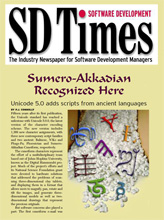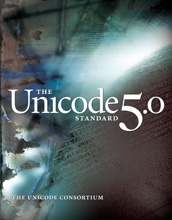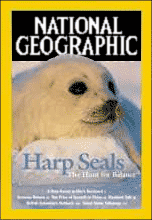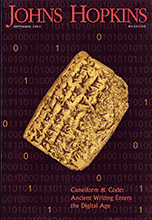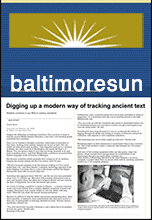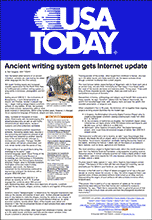Digital Hammurabi News
|
Applied Optics Journal, Front Cover
The most recent research article by the Digital Hammurabi Applied Physics Laboratory team, titled "Non-laser-based scanner for three-dimensional digitization of historical artifacts", made the front cover of the May 20, 2007 issue of the Applied Optics journal. From the abstract: "A 3D scanner, based on incoherent illumination techniques, and associated data-processing algorithms are presented that can be used to scan objects at lateral resolutions ranging from 5 to 100 m (or more) and depth resolutions of approximately 2 m. The scanner was designed with the specific intent to scan cuneiform tablets but can be utilized for other applications. Photometric stereo techniques are used to obtain both a surface normal map and a parameterized model of the object’s bidirectional reflectance distribution function. The normal map is combined with height information, gathered by structured light techniques, to form a consistent 3D surface. Data from Lambertian and specularly diffuse spherical objects are presented and used to quantify the accuracy of the techniques."
|
|
|
Big History: From the Big Bang to the Present
American Book Award-winning author Cynthia Stokes Brown writes in her 2007 book, Big History: From the Big Bang to the Present: "About 300 people today read cuneiform. Johns Hopkins University has established a project, called Digital Hammurabi, whose goal is creating an electronic archive of all known tablets in 3-D images so that scholars around the world can work on translating them."
|
|
|
Software Development Times Trade Journal
Software Development Times notes the acceptance of cuneiform in Unicode 5.0 in its October 15, 2006 issue: "Sumero-Akkadian Recognized Here - Unicode 5.0 adds scripts from ancient languages
The cuneiform characters represent the effort of a multidisciplinary team based out of Johns Hopkins University, known as the Digital Hammurabi project." |
|
|
Sumero-Akkadian Cuneiform Officially in Unicode
Cuneiform was officially accepted into Unicode 5.0 in 2006, seven years after ICE started the process. From the Unicode 5.0 acknowledgements section: "For Sumero-Akkadian Cuneiform: Michael Everson, Karljürgen Feuerherm, Steve Tinney, Madeleine Fitzgerald, and Cale Johnson. This script addition was aided in part by funds made available to participants by Johns Hopkins University through the Initiative for Cuneiform Encoding, by the National Science Foundation through the Digital Hammurabi Project, by the Society of Biblical Literature, and by the Script Encoding Initiative, University of California Berkeley. Special thanks are due to Dean Snyder and Jerrold S. Cooper of Johns Hopkins University for their leading roles in organizing and hosting two ICE conferences that were crucial to progress on the encoding."
The code point charts are divided between the core signs cuneiform signs and those covering the numbers and punctuation. |
|
|
Persica, Collège de France
Marie-Françoise Clergeau writing in the November 21, 2005 issue of the French journal, Persica: "These circumstances allow us to appreciate ... initiatives in the area of digitization related to these small archaeological objects: ... the development of a 3D color (or grayscale) scanner dedicated to cuneiform tablets, by the Digital Hammurabi project, which does not aim, for the moment, at Achaemenid period production but would seem to be just as perfectly suited for bullae and coins, as it is for tablets."
|
|
|
Cornell Library
The Cornell Library Preservation and Conservation 2005 issue says: "Because of the multiple surfaces of the tablets, it is rarely possible to reproduce the text so scholars must travel to the site where they are kept in order to see them. However, there is much promise in projects to digitize them (for example, the United States Science Foundation has funded Digital Hammurabi, a project to create a permanent record of texts, which will help to guard them against looters or other damage)."
|
|
|
National Geographic Magazine
National Geographic magazine wrote about Digital Hammurabi in their March 2004 issue: "Scholars mourned when archaeological artifacts in Iraq were looted or destroyed in the aftermath of the recent war. But in the future there may be a way to create a lasting record of irreplaceable artifacts. The Digital Hammurabi Project, begun at Johns Hopkins University in Baltimore, is working with companies like Arius 3D in Toronto to develop high-resolution scanners that create detailed images such as this one of a seventh-century B.C. cuneiform tablet found in Mesopotamia. Some 300,000 tablets eventually could be scanned and their images made available through the Internet."
|
|
|
Hopkins Magazine Cover Page & Lead Article
Digital Hammurabi and ICE were featured on the front cover and as the lead article of the September 2003 Hopkins Magazine. "Funded by $1.65 million from the National Science Foundation, Digital Hammurabi aims to create electronic archives of detailed, three-dimensional images of cuneiform tablets. Secondarily, work supported by the grant may eventually enable scholars to write cuneiform on a computer, something currently problematic because there is no standard computer encoding of cuneiform signs."
|
|
|
Baltimore Sun Newspaper
The Baltimore Sun newspaper ran a feature article on Digital Hammurabi in its February 16, 2003, Sunday edition. "The clay tablets are often discovered in pieces. 'One fragment could go to a museum in Britain, the other could be in Philadelphia and maybe the third is in Britain. You can spend a third of your time just doing footwork to try and track everything down,' said Piotr Michalowski, a professor of ancient Near Eastern languages at the University of Michigan. But a team of professors and scientists is working at the Johns Hopkins Applied Physics Laboratory in Howard County and on the Homewood campus in Baltimore to change that by creating an Internet library of scanned cuneiform tablets."
|
|
|
Applied Physics Laboratory News
Applied Physics Laboratory July, 2002: "... the team will develop a portable, very high resolution (100 lines per millimeter) 3-D scanner that will scan all facets of a cuneiform tablet in under a minute. New software will permit users to rotate, pan, tilt, zoom and relight the resulting virtual tablets in real time. And the team will devise imaging algorithms as they invent a completely new technology: automated 3-D character recognition of cuneiform writing."
|
|
|
The Library Journal
The May 30, 2002 issue announced: "One project, entitled "Digital Hammurabi: High-Resolution 3D Imaging of Cuneiform Tablets," will use a $1.55 million grant to create three-dimensional images of ancient cuneiform tablets, the oldest written documents in the world. That project will be a collaborative effort between the Sheridan Libraries and the university’s Computer Science Department."
|
|
|
USA Today Newspaper
USA Today newspaper wrote about Digital Hammurabi on May 21, 2002: "The most ambitious project is Digital Hammurabi, which this month received a grant from the National Science Foundation, a big supporter of putting science resources online. A normal computer scanner can make a digital photo of most early tablets. Later ones require the 3-D view because scribes of the time wrote on every side of a tablet. 'A photo doesn't really capture it,' says Johns Hopkins Assyriologist Jerrold Cooper. 'The beauty of this is that with fast and cheap 3-D scanning, we can practically put the tablet in your hands on your desktop,' he adds."
|
|
|
Hopkins Gazette
The May 13, 2002 issue of the Hopkins Gazette announced: "Digital Hammurabi ... will get a $1.55 million grant and brings together researchers from the Whiting School's Computer Science Department, the Sheridan Libraries, the Krieger School's Near Eastern Studies Department and the Applied Physics Laboratory. 'This is an exciting opportunity to combine applied technical research with a compelling scholarly need,' said Lee Watkins, assistant dean of the libraries and director of the Center for Scholarly Resources."
|
|
|
Near Eastern Archaeology Journal
In an article focusing on the Pennsylvania Sumerian Dictionary project the December 2002 issue of the Near Eastern Archaeology journal mentions: "Other projects include Oxford's Electronic Text Corpus of Sumerian Literature and Johns Hopkins University's Digital Hammurabi project."
|
|
|
Applied Physics Laboratory Update
The May 12, 2002 issue of the Johns Hopkins Applied Physics Laboratory Update announces: "With a $1.55 million grant from the National Science Foundation, APL and three other Hopkins entities will collaborate over the next 3 years to develop a Virtual Cuneiform Library. Cuneiform is the oldest known writing. The earliest texts, made by pressing sticks into damp clay tablets, appeared in Mesopotamia about 3200 B.C. These tablets are scattered in museums throughout the world, making it hard for scholars to see them all; only one-tenth of all existing cuneiform texts have ever been read even once in modern times."
|
|
|
Hopkins Magazine
The Summer 2001 issue of the Hopkins Magazine featured an article on the Intitiative for Cuneiform Encoding, which later became a part of Digital Hammurabi: "Snyder is also a philologist who trained in comparative Semitics at the Oriental Institute of the University of Chicago. He has founded the Initiative for Cuneiform Encoding, an international group of cuneiformists, computer software engineers, linguists, and other specialists who want to establish a global standard for the computer encoding of Sumero-Akkadian cuneiform, the oldest known form of writing."
|
|
|
Hopkins Arts & Sciences News
Krieger School of Arts & Sciences November 2000 News: "Hopkins witnessed an interesting marriage of the old and the new this month when leading experts in Sumero-Akkadian cuneiform, the world's oldest attested writing system, met with leading experts in one of the world's newest writing systems, Unicode."
|
|
|
|
$1.63 Million National Science Foundation Grant
The NSF awarded Digital Hammurabi and ICE a 3-year, $1.63 million grant in April 19, 2002 to build a 3D scanner for cuneiform tablets and encode the cuneiform script. One of the reviewers of the proposal said that it was "head-and-shoulders above the others we reviewed, and among the best of it's kind we've seen in years."
|
|
|
Access To World's Best Cuneiform Sign Lists
Dr. Miguel Civil, Dr. Rykle Borger, and Dr. Robert England, authors of the three most important cuneiform sign lists in the world, all of them previously unpublished, and some in development for more than 40 years, each gave ICE permission to use their unpublished materials in generating its encoding. The cuneiform sign repertoire embodied in the ICE proposal is truly an historic milestone in cuneiform studies, representing, as it does, the merger of these three lists. |
|
2nd International ICE Conference
The second international ICE conference was hosted again at Johns Hopkins, on June 5-6, 2003. Plans were finalized for the formal proposal to Unicode. Dr. Steve Tinney, Dr. Madeleine Fitzgerald, and Cale Johnson would do most of the editing of the sign repertoire; Tinney, with technical help from Michael Everson, would create the cuneiform font for the proposal. |










